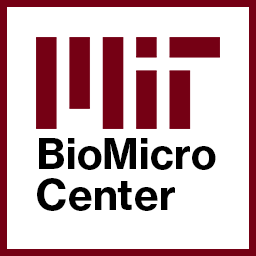BioMicroCenter:ChIP
HOME -- SEQUENCING -- LIBRARY PREP -- HIGH-THROUGHPUT -- COMPUTING -- OTHER TECHNOLOGY
The BioMicro Center now supports preparation of Chromatin IP samples. Basics about Chromatin IP can be found at this link.
Automated ChIP[edit]
Chromatin IP is one of the more complicated methods available through the BioMicro Center. In order to make this method reproducible enough to be run in a core facility, the BioMicro Center has automated the process through the use of the Diagenode IP-Star. The IP-Star begins with sonicated chromatin and antibody and proceeds through the blocking, hybridization, washing and reverse crosslinking steps. RNaseA, ProteinaseK and cleanup steps are performed in the BioMicro Center off instrument and yields are assessed by Bioanalyzer. These ChIP samples may be picked up for qPCR (if only interested in a select few binding sites) or sent directly to SPRI for library construction and sequencing (options are listed on submission forms). In the event that the ChIP samples fail QC, the samples will not be submitted to SPRI-works but will be charged for the IP.
The Diagenode IP-star is a single purpose robot designed to handle IPs. The IP-Star has a throughput of 8 samples per day. The samples can vary on cell types, antibodies or buffer conditions, though the timing must remain constant. The system mixes the samples by repeatedly pipetting them. To separate the beads from the supernatant, the IP-Star works by placing a magnet next to the tips, retaining the beads in the tip while allowing the rest of the chromatin or washes to be removed. Once the sample is eluted from the beads, reverse crosslinking is initiated and the beads are removed from the sample.
Sample Preparation[edit]
The IP-star requires 5 million cells per IP. Sonicated chromatin must be submitted at 5-7 million cells per 200 uL volume. Antibodies must be submitted at the same time(at least 3 ug of antibody per IP). It should work with many different cell lysis / crosslinking conditions. We have validated the protocol below and strongly recommend using it as a baseline:
1. Resuspend fixed cells in 10 mL of LB1
2. Rock cells at 4 degrees for 10 minutes
3. Pellet cells at 4 degrees for 5 minutes at 1350g
4. Remove supernatant and resuspend cells in 10mL of LB2
5. Rock cells at 4 degrees for 10 minutes
6. Pellet cells at 4 degrees for 5 minutes at 1350g
7. Remove supernatant and resuspend cells in a volume of LB3 where there is 5 million cells/200uL
**Example: Resuspend 25 million cells in 1mL of LB3** 8. Sonicate cells
9. Pellet debris at 4 degrees for 10 minutes at 20,000g
10. Submit lysate for ChIP
Sonication conditions vary broadly between different cell types and different sonicators so you will want to optimize your conditions to produce material in the 100-500bp range. We strongly recommend that you not freeze your lysate before submitting to ChIP prep. Therefore, it is critical that you coordinate with BioMicro Center staff members to be sure that space is available on the IP-Star when your cells are ready. For scheduling, you may email Shmulik Matola at Shmulikm@mit.edu.
IP Conditions[edit]
ChIP-seq[edit]
Chromatin Immunoprecipitation Sequencing (ChIP-Seq) combines ChIP with DNA sequencing, allowing researchers to identify the binding sites of DNA-associated proteins. It can be used as a more cost effective and higher quality alternative to whole genome microarray hybridization. You can find more information about Illumina's ChIP-Seq protocols and kits here. ChIP-Seq samples are typically run as 36nt or 40nt single-end runs on the GAIIx or HiSeq, respectively.
ChIP Seq Literature[edit]
<biblio>
- Paper1 pmid=18692474 <!-mirna 2008->
- Paper2 pmid=17558387
</biblio>

